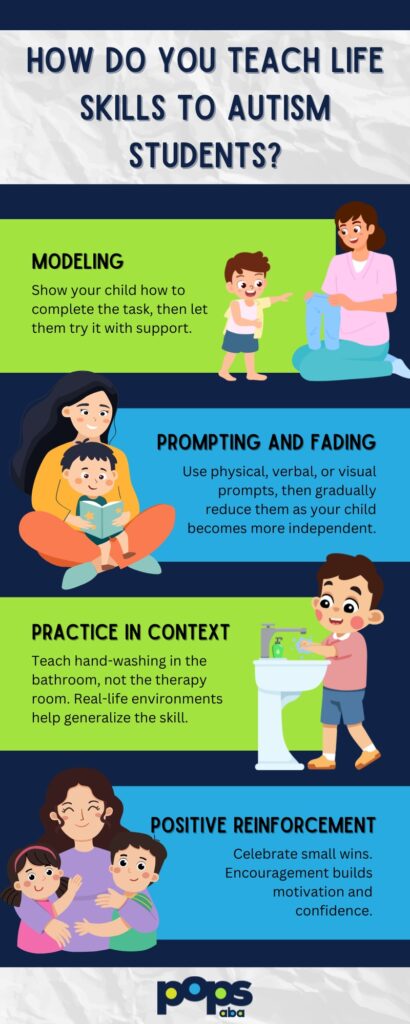Key Points:
- Life skills for autism students are crucial for building independence, confidence, and long-term quality of life.
- Teaching life skills involves breaking tasks into manageable steps and using real-life settings and routines.
- ABA therapy can play a valuable role in reinforcing practical skills and supporting generalization across environments.
Teaching math is one thing. Teaching how to brush teeth, make a snack, or ask for help? That’s a whole different skill set. Life skills for autism students are often overlooked—but they’re essential. And with some structure and support, these everyday tasks can become second nature.
Do Autism Students Need Life Skills?
Yes, life skills for autism students are essential. These skills help children and teens with autism navigate daily routines, build independence, and function more confidently at home, school, and in the community. Life skills range from hygiene and safety to money management and emotional regulation—critical for a fulfilling life.
What Are Life Skills and Why Are They Important for Autism?
When people think about helping kids with autism, their minds often go to speech, social skills, or academic support. But just as important—sometimes more so—are life skills: the day-to-day abilities that allow someone to care for themselves, interact safely with the world, and make choices.
For autism students, life skills serve as the bridge between therapy sessions and real-world independence. They allow children to feel more capable and reduce the need for constant adult assistance. That can be liberating not just for the child, but also for parents, caregivers, and educators who want to see their child thrive.
Which Life Skills Should Be Prioritized?
While every child is different, certain foundational life skills apply across most situations. These core skills make up the backbone of daily functioning and are often the best place to begin.
Choosing which life skills to teach should be based on your child’s age, abilities, and goals. Below are essential categories that most children with autism benefit from learning:
1. Self-Care and Personal Hygiene
Mastering hygiene and grooming is a vital first step toward independence. These tasks not only help with health but also increase social acceptance and personal comfort.
- Brushing teeth, washing hands, and bathing
- Using the toilet independently
- Getting dressed appropriately for the weather or the occasion
- Managing menstruation (for girls and teens)
2. Safety Awareness
Safety is non-negotiable, and it’s often one of the first concerns for parents. Teaching safety skills is a proactive way to prevent accidents and build self-reliance.
- Understanding personal boundaries and stranger danger
- Recognizing traffic signals and pedestrian safety
- Knowing basic emergency procedures (e.g., calling 911)
- Learning to respond to fire alarms or weather alerts
3. Basic Household Responsibilities
Even small chores can build a sense of ownership and confidence. These skills also prepare children for greater independence in adulthood.
- Cleaning up after themselves (dishes, toys, spills)
- Doing laundry with support or independently
- Preparing simple meals or snacks
- Following a basic chore schedule
4. Functional Communication
While this isn’t a “traditional” life skill, communication underpins nearly every daily task. Whether verbal or using AAC (Augmentative and Alternative Communication), clear expression is critical.
- Asking for help or clarification
- Expressing wants, needs, and discomfort
- Following directions and routines
- Reporting emergencies or unusual situations
5. Money and Time Management
These higher-level skills are often introduced in later elementary or teen years but are no less vital.
- Recognizing money and understanding basic purchases
- Using a schedule or calendar
- Learning to save, budget, and prioritize tasks
- Managing allowance or simple financial exchanges
How Do You Teach Life Skills to Autism Students?
Teaching life skills for autism students doesn’t follow a one-size-fits-all approach. It requires breaking tasks down, using visual supports, and building on real-life practice. Patience and consistency are key.
Start by identifying what skill your child is ready to learn. Pick one skill at a time and introduce it in a low-pressure, structured environment. Visual schedules, social stories, and task analyses (breaking tasks into smaller steps) can make abstract tasks more concrete.
Here are some strategies that help:

Can Life Skills Be Taught at Home?
Absolutely, and in fact, home is one of the best places to teach and reinforce life skills. Parents and caregivers are uniquely positioned to create natural learning moments throughout the day, whether it’s cooking dinner, setting the table, or folding laundry.
You don’t need a special curriculum to build life skills. Everyday routines are full of teachable moments.
Here’s how to incorporate life skill learning at home:
- Morning and Bedtime Routines: Practice brushing teeth, dressing, or using the toilet with step-by-step guidance.
- Meal Prep: Let your child help with pouring, stirring, or assembling simple meals. Start small and build confidence.
- Cleaning Up: Involve your child in tidying their room or sorting laundry. Use checklists or visual reminders as needed.
- Budgeting and Shopping: Take them on grocery trips and teach how to identify items, compare prices, and use money.
How Does ABA Therapy Help Teach Life Skills?
While parents and educators play key roles, ABA (Applied Behavior Analysis) therapy offers a structured and highly effective framework for teaching life skills for autism students. ABA breaks down complex tasks into smaller, teachable steps, and uses reinforcement to encourage independence.
In ABA therapy, life skills are not taught in isolation—they’re embedded into routines and goals specific to each child’s needs. Therapists observe how a child responds to tasks, adjust teaching methods, and track progress closely to ensure skills stick over time.
ABA also helps in these ways:
- Individualized Goal Setting: Therapy targets skills relevant to your child’s age, environment, and future needs.
- Generalization: ABA ensures that skills learned in a session can be used across different settings (home, school, public spaces).
Behavioral Support: ABA helps address any behaviors that may interfere with learning, like task refusal or anxiety.

What Challenges Might You Face—and How Do You Overcome Them?
Let’s be real: teaching life skills isn’t always smooth sailing. You might hit resistance, regressions, or sensory issues. The key is persistence, adaptability, and celebrating small victories.
Here are a few common hurdles and how to address them:
- Lack of Interest: Try turning the task into a game or linking it to a favorite item or activity as a reward.
- Sensory Sensitivities: Modify the task—if your child hates certain textures or sounds, find alternatives or gradual exposures.
- Skill Generalization: Practice the same task in different environments. For example, practice dressing both at home and at grandma’s house.
- Slow Progress: Keep expectations realistic. Some skills take weeks or months to master, and that’s okay.
ABA Therapy in New Jersey and North Carolina — Helping Your Child Build Real-Life Independence
When it comes to teaching life skills for autism students, consistency and expert support make all the difference. At Pops ABA, we specialize in using the power of ABA therapy to help children gain real-world abilities that last a lifetime. Whether your child is learning to brush their teeth, follow routines, or manage tasks at school, our team provides compassionate, individualized support every step of the way.
Looking for ABA therapy services in North Carolina and New Jersey? Reach out to us today and discover how structured, evidence-based therapy can help your child grow into a more independent and confident version of themselves, one life skill at a time.



